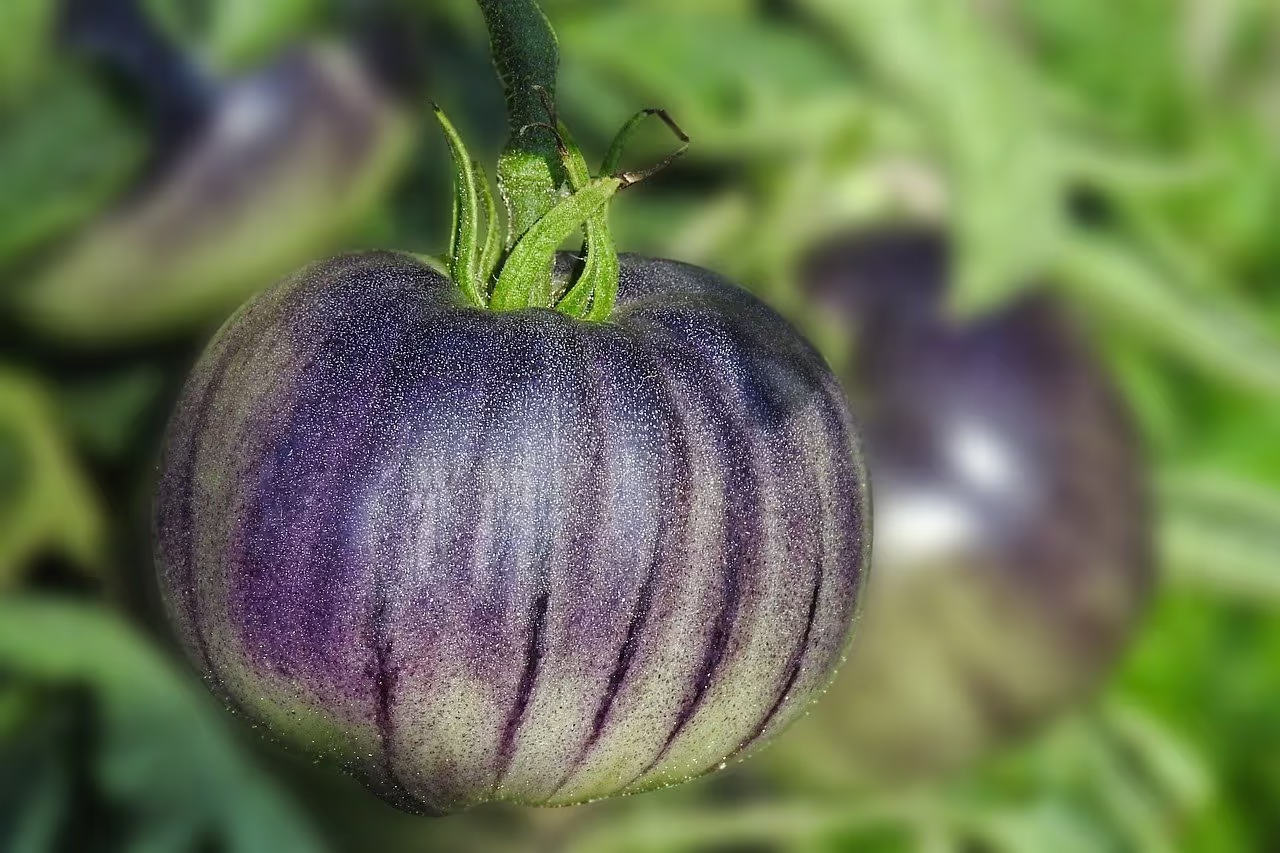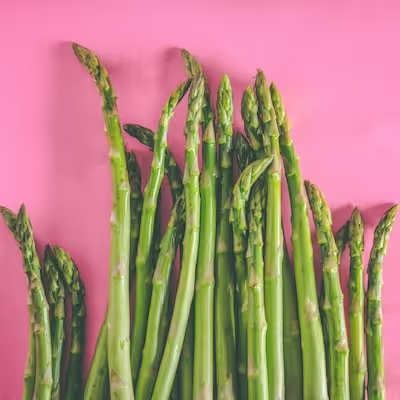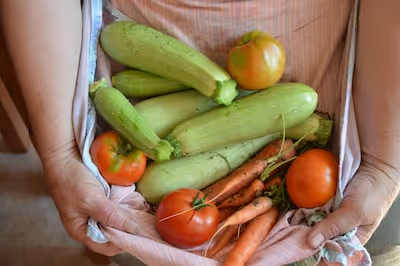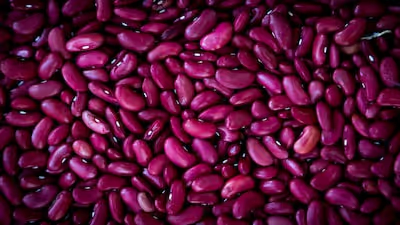Growing Indigo Rose Cherry Tomatoes: A Gardener's Guide

Growing Indigo Rose Cherry Tomatoes
Growing Indigo Rose Cherry Tomatoes kicks off with full sun, fertile soil, and steady watering. Start seeds indoors six weeks before frost clears, transplant deeply after risks pass, and stake early since plants climb vigorously. Indigo Rose, a striking purple-black tomato, rewards gardeners generously—keep reading for harvesting advice, feeding secrets, and pro tips that coax peak flavor from every picking.
Cheatsheet: Indigo Rose Cherry Tomato Success
🌱 Start Indoors
- Sow seeds 6-8 weeks before last frost (60-75°F / 15-24°C)
- Use sterile seed starting mix
- Provide 14-16 hrs light daily
- Transplant seedlings at 2-3" (5-7cm) tall
🌞 Outdoor Planting
- Harden off 7 days before planting out
- Soil temp: 60°F+ (16°C+)
- Spacing: 24-36" (60-90cm) apart
- Full sun (6-8 hrs+)
- Amend soil with compost
💧 Watering & Feeding
- Water deeply 1-2x/week (1" or 25mm)
- Mulch to retain moisture, prevent disease
- Feed with balanced organic fertilizer every 3-4 weeks
🕷️ Pest & Disease Watch
- Scout for tomato hornworm, aphids, blight
- Use neem oil or insecticidal soap as needed
- Prune lower leaves for airflow
🍅 Harvest
- Pick when fruit turns glossy purple-black with red blush
- Ripens in 75-80 days after transplant
🦾 Tools and Products You'll Need
- Seed trays & labels
- Grow lights
- Compost & organic fertilizer
- Pruners & gloves
- Tomato cages or stakes
- Mulch
🥗 Health & Nutrition
High anthocyanin content (antioxidant), vitamin C, lycopene. Eat fresh for best nutrition.
🌿 Self-Sufficiency Tip
Save seeds from healthiest fruit; store dry, cool for next season.
-
What makes Indigo Rose different
I grow Indigo Rose for the moody color and the way it shrugs off sun like a lizard on hot stone. The skins load up with anthocyanin where sunlight hits, which is why the shoulders turn inky purple while shaded areas stay paler until ripening.
Here is the trick with ripeness. Pick when the underside flushes deep brick red, the purple darkens, and the fruit gives slightly at the calyx.
Expect indeterminate vines that climb hard. In my beds they run 6 to 8 feet tall (1.8 to 2.4 m) with steady trusses once the weather settles.
Days to maturity sit around 75 to 80 from transplant, slower than candy-sweet cherries like Sungold. The payoff is a balanced, winey flavor that sweetens after three days on the counter at 68 to 72 F (20 to 22 C).
Seed and plant sourcing
For Growing Indigo Rose Cherry Tomatoes, start with clean seed from reputable vendors. I have had reliable stock from regional seedhouses that list breeder lineage and lot tests for germination and disease.
Look for packets that note days to maturity, growth habit, and anthocyanin expression. If buying starts, choose short, stocky plants with dark green leaves and no flowers yet.
Grafted options ride through cool soils and soil-borne disease. They cost more, yet they pay off in tired beds or if you push production into fall.
Site, soil, and prep
Full sun rules, with 6 to 8 hours minimum. Tomatoes thrive when daytime temperatures ride 70 to 85 F (21 to 29 C) and nights sit 55 to 70 F (13 to 21 C).
Work 2 to 3 inches of finished compost into the top 8 to 10 inches of soil (5 to 7.5 cm into 20 to 25 cm). Aim for pH 6.2 to 6.8, which keeps calcium and micronutrients available.
I blend in a low-chloride, slow-release base feed at planting, something near 5-10-10. A calcium source helps head off blossom end rot if your soil runs light on Ca or swings dry and wet.
Starting seeds indoors
Sow 6 to 8 weeks before your last frost date. I plant seed 0.25 inch deep (6 mm) in a pre-wet, fine mix and maintain 75 to 80 F (24 to 27 C) until germination.
Give bright light for 14 to 16 hours daily to prevent stretch. A small fan builds stronger stems and dries leaf surfaces between mistings.
Fertilize very lightly after first true leaves with a half-strength, balanced liquid feed. Pot up once roots reach the cell bottom, then keep growth steady and squat.
Transplanting and spacing
Harden plants for 7 to 10 days, then set them out after soil reaches 60 F (16 C) and nights stay above 50 F (10 C). I bury stems to the first true leaves to promote adventitious roots.
Space 18 to 24 inches apart in row (45 to 60 cm) with 36 to 48 inches between rows (90 to 120 cm). Indigo Rose appreciates air around its canopy, especially in humid summers.
Trellis immediately. Delay invites tangles and disease-prone thickets.
Training and pruning
I run a single or double leader per plant on a sturdy trellis or string. Remove suckers below the first flower truss and any leaves that touch soil.
Stop pruning during heat spikes to keep fruit shaded under their own canopy. Sun-exposed fruit turn darker purple yet can scald without leaf cover.
Water, fertigation, and mulch
Consistent moisture prevents splitting and blossom end rot. Target 1 to 1.5 inches of water weekly (25 to 38 mm), adjusted for heat, wind, and soil texture.
Drip or soaker hoses feed the root zone while keeping leaves dry. A 2 inch mulch layer (5 cm) locks in moisture and tempers soil swings.
Side-dress once fruit set begins with a balanced or slightly higher potassium feed. In containers I run a mild weekly liquid feed and flush once a month with plain water.
Pollination and fruit set
Tomato flowers are self-fertile, yet they need vibration. I tap the trellis mid-morning on dry days and see better set in shoulder seasons.
Heat above 90 F (32 C) or nights below 55 F (13 C) drop set. Shade cloth at 30 percent helps in hot snaps while still coloring the skins.
Harvest timing and flavor
Color can mislead with this variety. Wait for the hidden cheeks to turn rich red and for a light gloss to develop over the purple.
Pick with the calyx on to reduce tearing. I like to clip in clusters, then finish-ripen on a cool bench at 60 to 65 F (15 to 18 C) for two days to concentrate sugars.
Expect a Brix in the 6 to 8 range under steady irrigation. Push it to 8 to 9 with lighter water late, but stop short of stress that stunts vines.
Pests, diseases, and IPM
Scout twice weekly. I flip leaves and check lower canopies for aphids, whiteflies, and early leaf spots.
Rotate out of nightshades for at least two seasons to cut soil inoculum. Space well, prune wisely, and water at soil level to reduce leaf wetness duration.
For chewing pests I spot-treat with Bt or spinosad in the evening and stop once predators show up. For foliar disease I start with copper or biofungicides at label rates before storms, then extend intervals during dry stretches.
If late blight appears in your area, strip lower leaves, increase airflow, and switch to a proven protective spray program. Remove and bag infected plants if lesions run ahead of you.
Containers and small spaces
Indigo Rose behaves well in big pots. I use 7 to 10 gallon containers (26 to 38 L) filled with a peat-free, airy mix and add extra perlite for drainage.
Feed little and often, and never let pots dry to dust. A fabric pot on a saucer with a timer-driven drip line saves time and fruit quality.
Flavor notes and kitchen use
These cherries lean savory with berry hints from the skins. I halve them with olive oil, salt, torn basil, and a spoon of sherry vinegar, or roast at 425 F (218 C) until edges wrinkle.
The purple skins char beautifully on a ripping-hot skillet. A quick pickle with 3 percent brine turns them into an umami snack that vanishes by midnight.
List: gear that actually helps
- Rigid cattle panel trellis or heavy-duty tomato cages that reach 5 to 6 feet (1.5 to 1.8 m)
- Drip line with 0.5 gph emitters spaced 12 inches (1.9 L/h, 30 cm)
- Mulch: clean straw, shredded leaves, or coarse compost
- pH test kit and agricultural lime or elemental sulfur for adjustments
- Sanitizable pruning shears and soft plant ties
- LED grow lights for starts, 200 to 400 PPFD at canopy
- Refractometer for quick Brix checks if you like data-driven harvests
Comparisons and alternatives
If you enjoy Growing Indigo Rose Cherry Tomatoes, you might like these cousins. Each offers a different balance of sugar, acid, and color.
- Blue Berries: smaller, very dark shoulders, quick to color, mild sweetness
- Indigo Cherry Drops: more uniform clusters, slightly brighter flavor
- Midnight Snack: glossy purple-black tops with red bottoms, tidy vines
- Brad’s Atomic Grape: elongated fruit, wild striping, richer umami when roasted
- Black Cherry: no anthocyanin, but deep mahogany and plush flavor
- Sungold: orange sugar bomb for contrast in salad bowls
Troubleshooting in 30 seconds
- Purple leaves on seedlings: often cool roots or P deficiency; warm the medium to 70 F (21 C) and feed lightly
- Green shoulders that stay hard: fruit shaded early; give time until the bottom reddens and the gel loosens
- Splitting after rain: pick blushing fruit before storms and finish indoors
- Blossom end rot: steady moisture, add calcium if soil tests low, avoid heavy ammoniacal N
- Blossom drop in heat: afternoon shade cloth and more airflow
- Bland flavor: too much water late; ease off slightly during final week
Where to buy and what to look for
Shop seed vendors that publish germination rates and disease testing, and that credit the OSU Indigo breeding line. For transplants, ask for disease-free certification and the sowing date.
Choose potting mix that drains fast yet holds moisture, with a starter charge around 0.5 to 0.8 lb N per cubic yard (0.3 to 0.5 kg). For fertility, pick tomato formulas with higher K than N once fruiting starts.
Field notes I trust
Anthocyanin only develops on sun-exposed skin, which is why fruits can look two-toned during ripening. The pigment deepens under strong light yet does not indicate sugar levels on its own.
Flavor improved when I pruned less in July, leaving dappled shade on clusters. That kept skins supple and cut sunscald after a heat spike.
Tomatoes prefer pH 6.2 to 6.8, at least 6 to 8 hours of direct sun, and soil temperatures above 60 F (16 C) at planting. Keep foliage dry to cut foliar disease pressure.
Indigo Rose matures about 75 to 80 days after transplant, with anthocyanin developing on the sun side and red pigments building in the shaded zones as the fruit ripens.
Trusted references and why they matter
Oregon State University developed Indigo Rose and documents how sunlight drives anthocyanin in the skin, which aligns with what I see in the field. Their notes on ripening cues prevent early picking.
The Royal Horticultural Society and multiple U.S. extension services outline best practice on spacing, watering at soil level, and pruning for airflow. Cornell and UC resources on tomato disease cycles sync with the IPM steps listed here.
Quick spec sheet for Growing Indigo Rose Cherry Tomatoes
- Type: indeterminate cherry, purple-shouldered skin with red undertones
- Maturity: 75 to 80 days from transplant
- Spacing: 18 to 24 inches in row (45 to 60 cm); tall support required
- Soil: pH 6.2 to 6.8, high organic matter, consistent moisture
- Water: 1 to 1.5 inches weekly (25 to 38 mm), drip preferred
- Use: fresh eating, roasting, quick pickles, color contrast in salads
Source notes
Oregon State University, Indigo tomato breeding program, public releases and extension bulletins. Royal Horticultural Society tomato growing guides on watering, feeding, and greenhouse culture.
Cornell University and UC Cooperative Extension publications on tomato spacing, disease, and IPM. National Gardening Association surveys repeatedly rank tomatoes as the top homegrown crop, which tracks with seed sales and my own waitlists for starts each spring.
Frequently Asked Questions About Growing Indigo Rose Cherry Tomatoes
What soil conditions best support Indigo Rose tomato plants?
Indigo Rose tomato plants thrive in fertile, well-drained soils with a neutral to slightly acidic pH of 6.0 to 6.8. Work generous amounts of rich compost or organic matter into your garden bed or container mix to deliver steady nutrients and improve soil structure.
How much sunlight do Indigo Rose tomatoes require?
These tomato plants require abundant sunlight—a minimum of 6 to 8 hours daily. Choose a planting location where plants can soak up full sun, encouraging healthier growth, strong stems, and enhanced fruit coloration.
What's the optimal watering schedule for Indigo Rose cherry tomatoes?
Maintain consistent soil moisture by watering deeply about 1 inch (2.5 cm) per week. Adjust based on rainfall and temperature. Provide water at the plant's base directly to roots in the early morning to minimize evaporation and reduce leaf diseases.
How should Indigo Rose tomatoes be spaced and supported?
Space Indigo Rose tomato plants approximately 24 to 36 inches (60 to 90 cm) apart to ensure good airflow and adequate sunlight. As they mature, support growth with sturdy stakes, cages, or trellises to keep fruits elevated, limit diseases, and simplify harvesting.
When should I harvest Indigo Rose cherry tomatoes?
Indigo Rose tomatoes ripen from a deep blue-purple to a reddish hue wherever exposed to sunlight. Pick fruits when they show vibrant color changes and feel slightly soft to the touch. Harvest frequently for peak flavor and to help stimulate continuous production.
Are Indigo Rose tomatoes susceptible to pests or diseases?
Like many tomato varieties, Indigo Rose plants can encounter pests such as aphids, hornworms, or whiteflies, and diseases like blight and blossom-end rot. Practice crop rotation, remove affected foliage promptly, and inspect plants regularly to spot and mitigate issues early.
Growing Indigo Rose Cherry Tomatoes rewards you with more than just a striking harvest. These deep purple gems thrive with sun-drenched spots, steady watering, and a little patience. Give them rich soil, prune for airflow, and you’ll get fruit that’s as flavorful as it is beautiful. Pair your Indigo Rose with herbs like lovage for a punchy companion planting combo, or review tomato planting basics if you want to sharpen your technique. In the end, you get a tomato that’s a showstopper—both on the vine and on the plate. Grow them once, and you’ll see why they’re a favorite for gardeners who want something a little wild, a little different, and unforgettable.
The Homesteader’s Approach to Indigo Rose Cherry Tomatoes
Seed Saving for Independence
Preserve seed viability by selecting fully ripened, disease-free Indigo Rose tomatoes. Extract seeds, ferment in water for 48-72 hours at 68-78°F (20-25°C), then dry thoroughly before storing in labeled, airtight containers at cool temperatures (40-50°F / 4-10°C).
Integrating Companion Plants
- Basil: Enhances flavor, deters pests.
- Marigolds: Repels nematodes, attracts pollinators.
- Nasturtiums: Diverts aphids, edible foliage and flowers boost salads.
Natural Pest Management
- Hornworms: Handpick at dusk, compost or feed to poultry.
- Aphids: Spray diluted neem oil (1 tsp per quart / 5ml per liter water) weekly until resolved.
- Whiteflies: Introduce ladybugs or lacewings for biological control.
Optimizing Nutritional Density
Increase antioxidants (anthocyanins) by positioning plants in full sun exposure. Apply compost tea biweekly to enhance trace minerals, boosting fruit nutritional value and resistance to pests.
Food Preservation Techniques
- Sun-drying: Halve tomatoes, sprinkle lightly with salt, dry 4-6 days in sunlight or 6-8 hours in dehydrator at 135°F (57°C).
- Pickling: Preserve firm fruits in vinegar-brine solution with garlic cloves, dill, peppercorns for nutrition-packed pantry staple.
- Freezing: Whole or sliced, flash-freeze tomatoes individually on tray before transferring to storage bags or vacuum sealing.
Yield and Sustainability Facts
- Single Indigo Rose plant typically yields 6-8 pounds (2.7-3.6 kg) per season.
- Prevents food waste by using imperfect fruit in sauces, soups, preserves.
- High anthocyanin content linked to reducing inflammation, improving cardiovascular health.
Find out which plants will thrive in your garden!
Answer a few fun questions and get custom plant recommendations perfect for your space. Let’s grow something amazing together!

start your season





